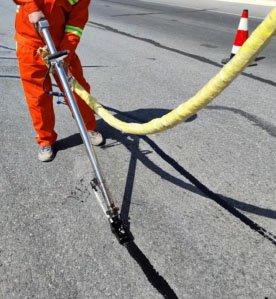1. Construction Overview
Pavement slotting and grouting construction is a preventive maintenance method for road surfaces with good base and cross-section, but with longitudinal and transverse cracks on the surface and low crack density. The purpose is to clean the cracks by slotting and then apply sealant to repair and prevent further expansion of the cracks, thereby extending the service life of the road.
2. Construction steps
Preparation stage: Check the slotting machine and grouting machine, start the grouting machine and heat the sealant to the required temperature for construction. Load the construction equipment onto the truck, tow it to the designated construction site, and seal off the construction area.
Slotting: Use a slotting machine to create slots with a width and depth of 1-1.5 centimeters along the direction of the crack, clean the debris and waste in the crack, and ensure that the sealant is firmly bonded to the pavement structure layer.
Cleaning the groove: Use a high-pressure air pump and a wire brush to clean the debris in the groove, ensuring that the groove is clean and free of debris.
Grouting: Evenly pour the sealant heated to the appropriate temperature into the groove to form a T-shaped sealing layer, ensuring that the sealant fills the groove.
Health preservation: After filling the seams, wait for the sealant to fully cool down, clean up road debris, and open up traffic.
3. Construction effect
The construction of road slotting and grouting can effectively solve the problem of road cracks, improve the service life of the road and the comfort of driving. By slotting and grouting, the debris and waste in the cracks can be thoroughly cleaned, ensuring a strong bond between the sealant and the pavement structure layer, thereby improving the overall strength and durability of the road.
4. Applicable scenarios and conditions
Road surface slotting and grouting are suitable for road surfaces with good base and cross-section, but with longitudinal and transverse cracks and low crack density on the surface. During construction, attention should be paid to the appropriate temperature (the best temperature is 5 ° C-35 ° C), and the construction area should be dry and clean to avoid construction on rainy days or when the temperature is too low.


